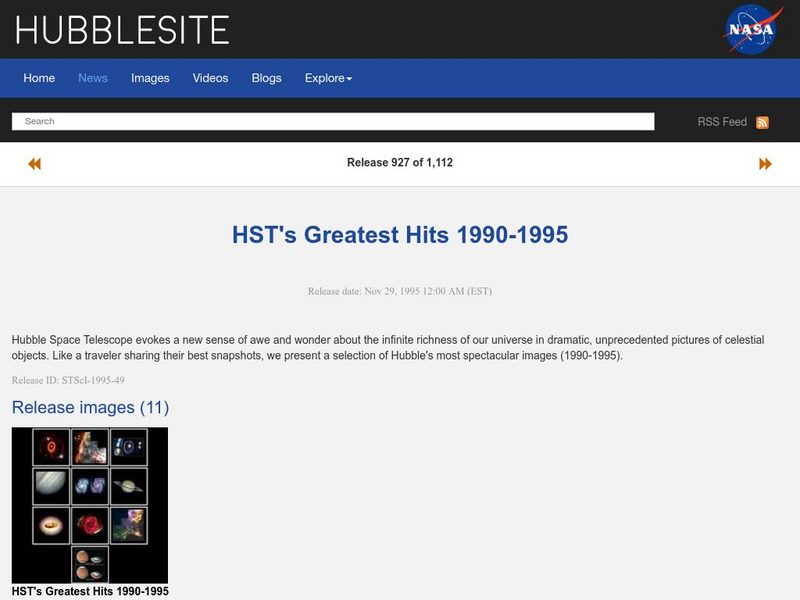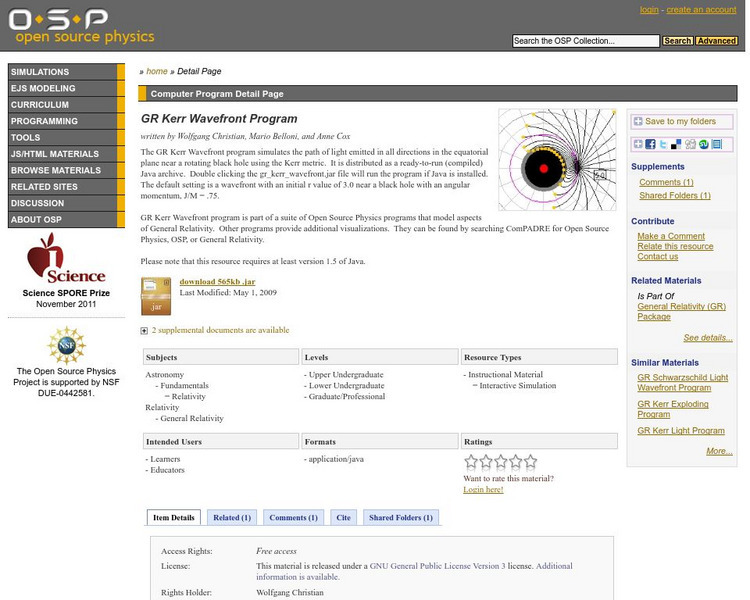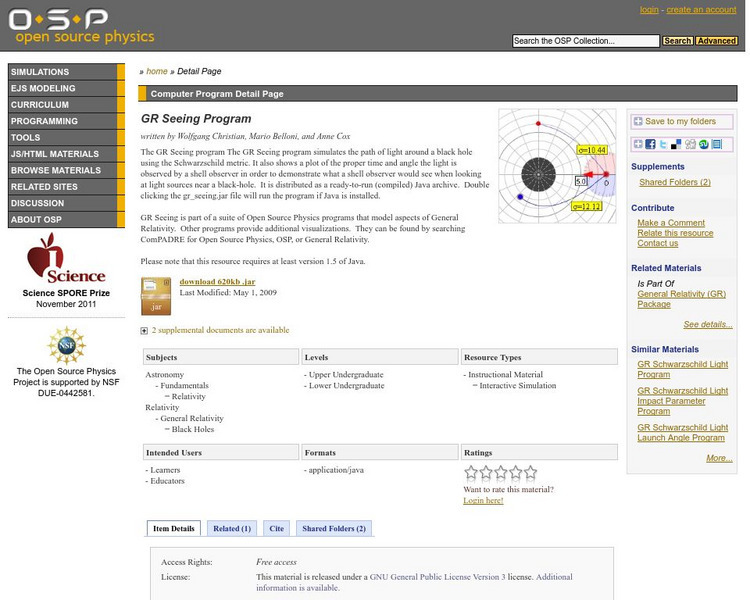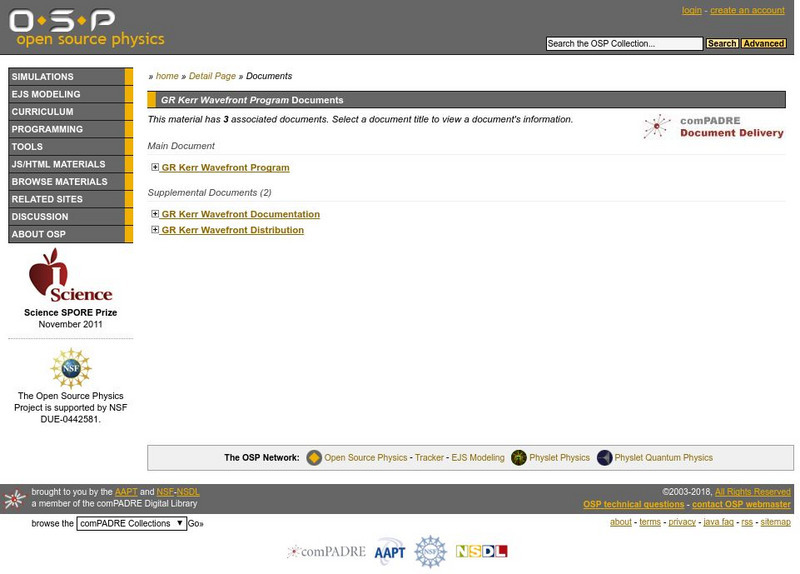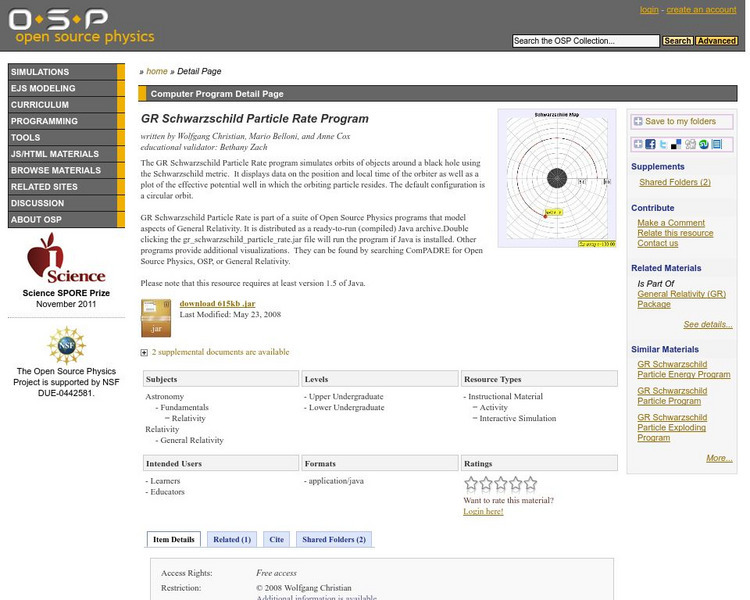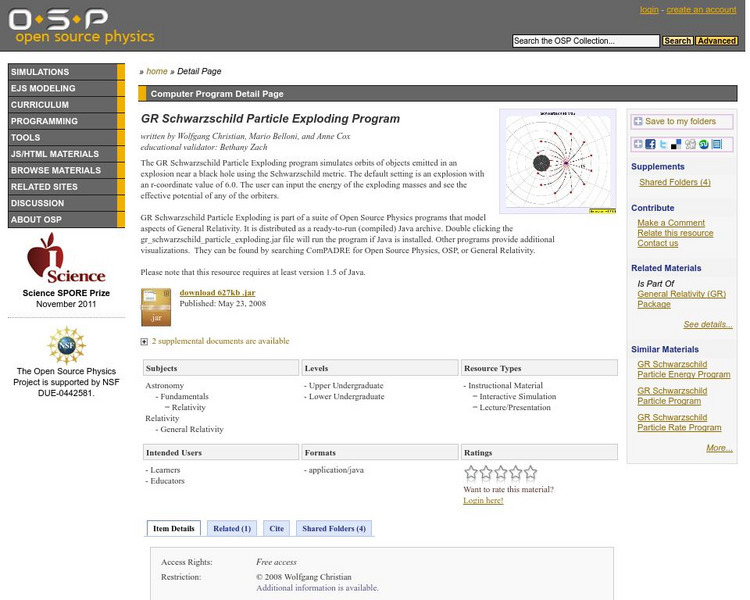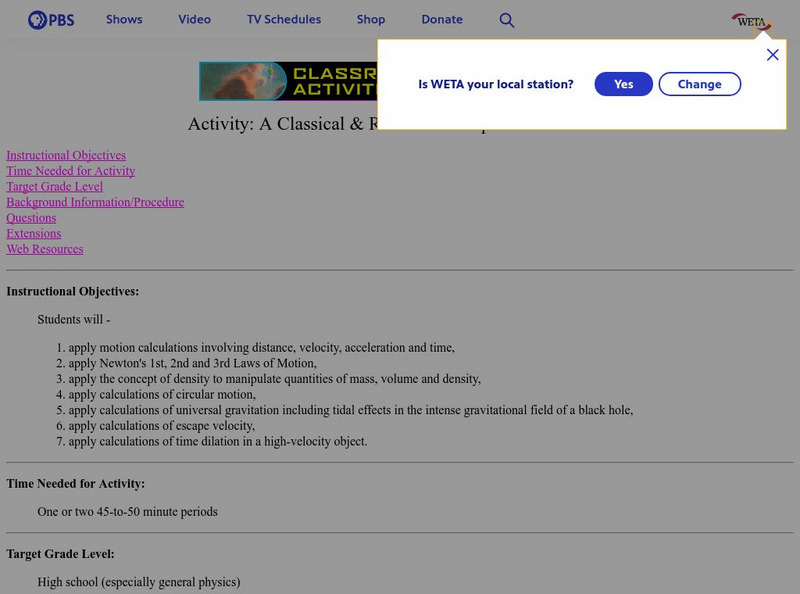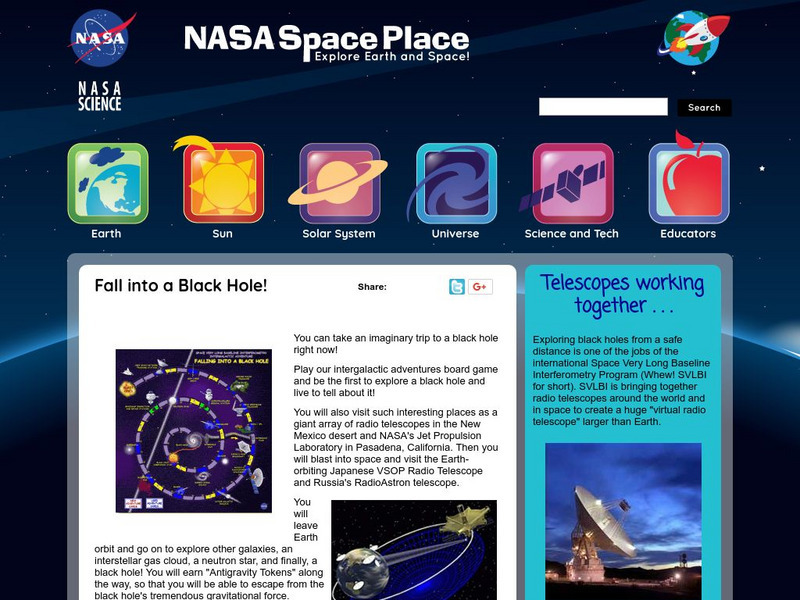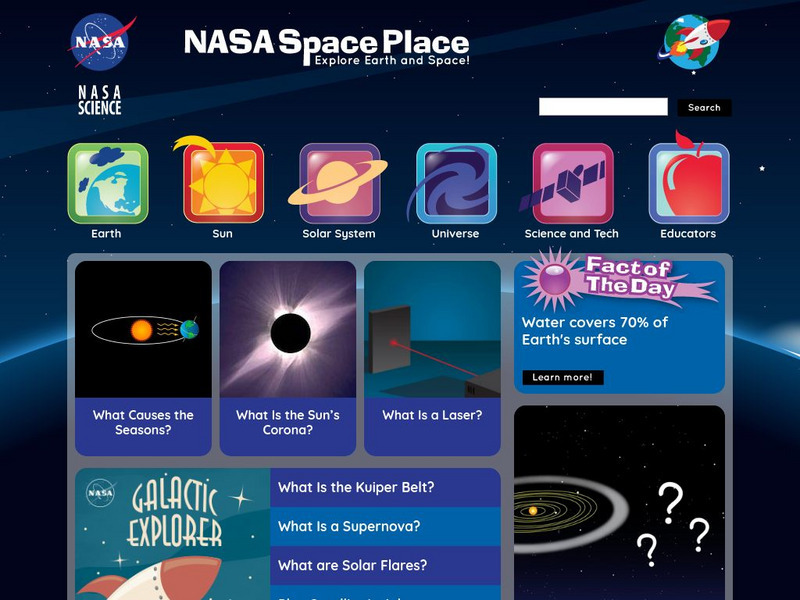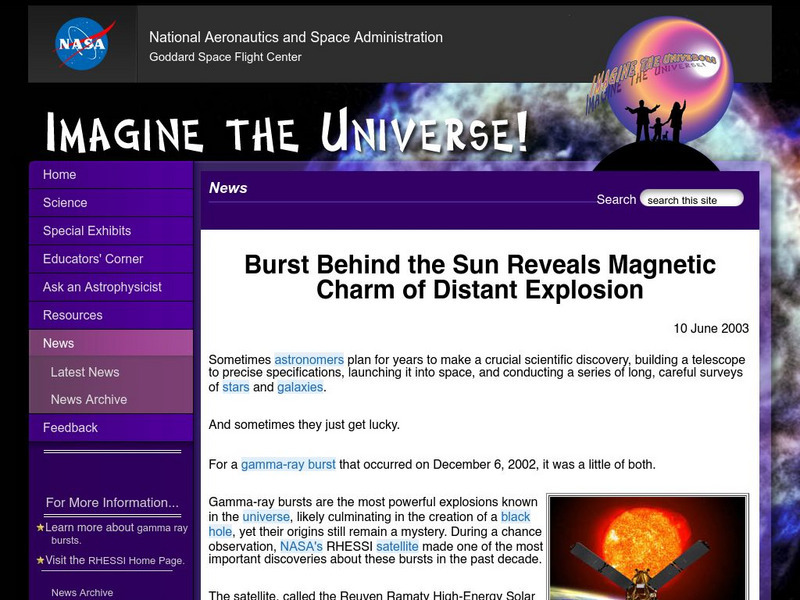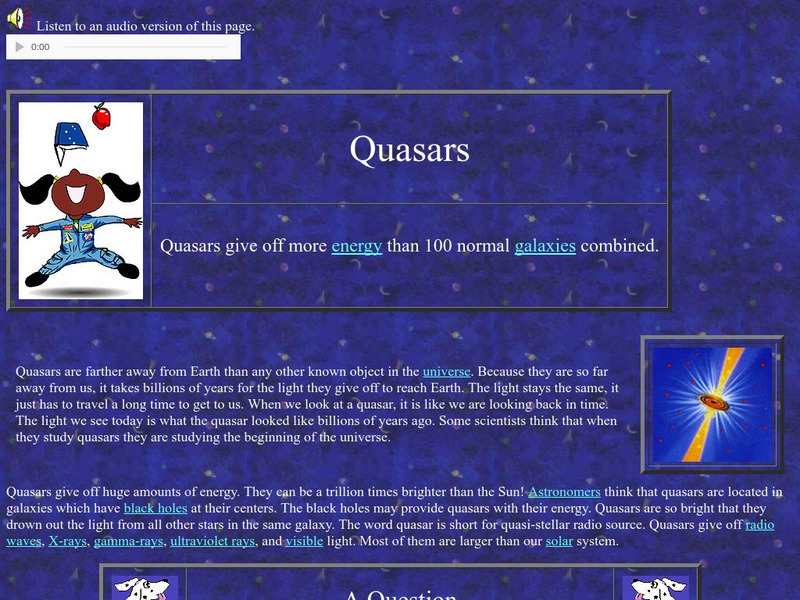Space Telescope Science Institute
Hubble Space Photographs: Hst's Greatest Hits 1990 1995
Breathtaking images from the Hubble Space Telescope give a new perspective to our world.
PBS
Pbs Learning Media: Birth of a Supernova, Type Ii
In this interactive activity from NOVA Online, learn about a type of exploding star a Type II supernova that is so large it has a mass 10 times greater than the mass of our Sun.
Massachusetts Institute of Technology
Mit: Open Course Ware: Exploring Black Holes: General Relativity and Astrophysics
College-level physics course focusing on black holes. Course topics include general relativity, astrophysics, and elements of cosmology . Course features include selected video lectures, lecture notes, assignments, and exams.
University of Wisconsin
The Why Files: 3 2 1 Contact, Don't Touch That Dial
A discussion of reflecting telescopes and their use in radio astronomy. The types of information gained from and the research emphasis fueled by such telescopes is described. Site uses Hollywood references and a humorous style.
Wikimedia
Wikipedia: The Black Hole
This site examines the black hole as an object in astrophysics. Delve into this comprehensive resource that covers this concept from its history, to qualitative physics, the reality of black holes, mathematical physics and more.
American Association of Physics Teachers
Com Padre Digital Library: Open Source Physics: Gr Kerr Wavefront Program
Using the Kerr metric this simulation illustrates the directions of light emitted from an equatorial plane near a rotating black hole.
American Association of Physics Teachers
Com Padre Digital Library: Open Source Physics: Gr Kerr Stone Program
Consider general relativity with this simulation using Kerr metric of orbits in an equatorial plane near a rotating black hole.
American Association of Physics Teachers
Com Padre Digital Library: Open Source Physics: Gr Kerr Light Program
Using Kerr metric this simulation illustrates the path of light emitted from the equatorial plane near a rotating black hole.
American Association of Physics Teachers
Com Padre Digital Library: Open Source Physics: Gr Seeing Program
Using the Schwarzchild metric this simulates the path of light from a black hole also identifying specific time and angle of the light.
American Association of Physics Teachers
Com Padre Digital Library: Open Source Physics: Gr Kerr Wavefront Program
A simulation that uses the Kerr metric to show the distribution of light photon trajectories when near a black hole that rotates. Accompanied by explanatory documentation.
American Association of Physics Teachers
Com Padre Digital Library: Open Source Physics: Gr Schwarzschild Time Program
This simulation uses the Schwarzschild metric to illustrate the local time at points near a black hole in comparison to time measured farther away. Sinusoidal signals are also shown.
American Association of Physics Teachers
Com Padre Digital Library: Open Source Physics: Particle Rate Program
A simulated opportunity to test the Schwarzschild metric as objects orbit around a black hole.
American Association of Physics Teachers
Com Padre Digital Library: Open Source Physics: Particle Exploding Program
Take a look at general relativity with this science simulation illustrating orbits of objects that are the result of an explosion near a black hole measured in Schwarzschild metric. Users are able to adjust the energy from the exploding...
American Association of Physics Teachers
Com Padre Digital Library: Open Source Physics: Schwarzschild Particle Energy
Apply the Schwarzschild metric to an object orbiting about a black hole. Manipulate the energy and angular momentum of the orbiting particle and observe the results.
American Association of Physics Teachers
Com Padre Digital Library: Open Source Physics: Schwarzschild Light Wavefront
Apply the Schwarzschild metric to the paths light travels when it radiates in every direction near a black hole. Adjust the position of the light source and observe the effective potential of the paths.
PBS
Pbs: A Classical and Relativistic Trip to a Black Hole
This PBS site is a classroom activity that takes a trip to a black hole. Students apply calculations on distance, velocity, acceleration, time, circular motion, density, and more.
Other
Astromador: Astronomia Para Amadores
This resources focuses exclusively on astronomy. It's packed with historical facts about space exploration, famous people who pioneered the study of stars and planets. It features chronological list of space exploration, current news,...
NASA
Nasa: Fall Into a Black Hole!
This site from the National Aeronautics and Space Administration allows one to play "Falling into a Black Hole," and take an imaginary trip to a black hole right now!
NASA
Nasa: The Space Place
This site from the National Aeronautics and Space Administration allows students to explore topics related to planet earth and outer space. A number of games and interactive features are available.
Libre Text
Libre Texts: Chemistry: Black Hole Thermodynamics
Why did black holes enter the realm of thermodynamics? This concise article dives into the history.
NASA
Nasa: Imagine the Universe: "Burst Behind the Sun"
Site provides the article, "Burst Behind the Sun Reveals Magnetic Charm of Distant Explosion," that details on a gamma-ray burst that occurred on December 6, 2002. Provides graphics and links to learn more about gamma-ray bursts.
NASA
Nasa Star Child: Quasars (Level 1)
Learn why quasars are the brightest things in the universe. Vocabulary words linked to a glossary of terms and a printable version are available.
NASA
Nasa Star Child: Comets (Level 1)
Younger students learn why comets race through the sky as well as related vocabulary words and meanings.
Space Telescope Science Institute
Amazing Space: No Escape: The Truth About Black Holes
This site is for teachers or anyone interested in detailed information on black holes. Lesson plans are included as well as a grab bag of web images. Students have a chance to write and submit a paper on black holes and to explore the...


